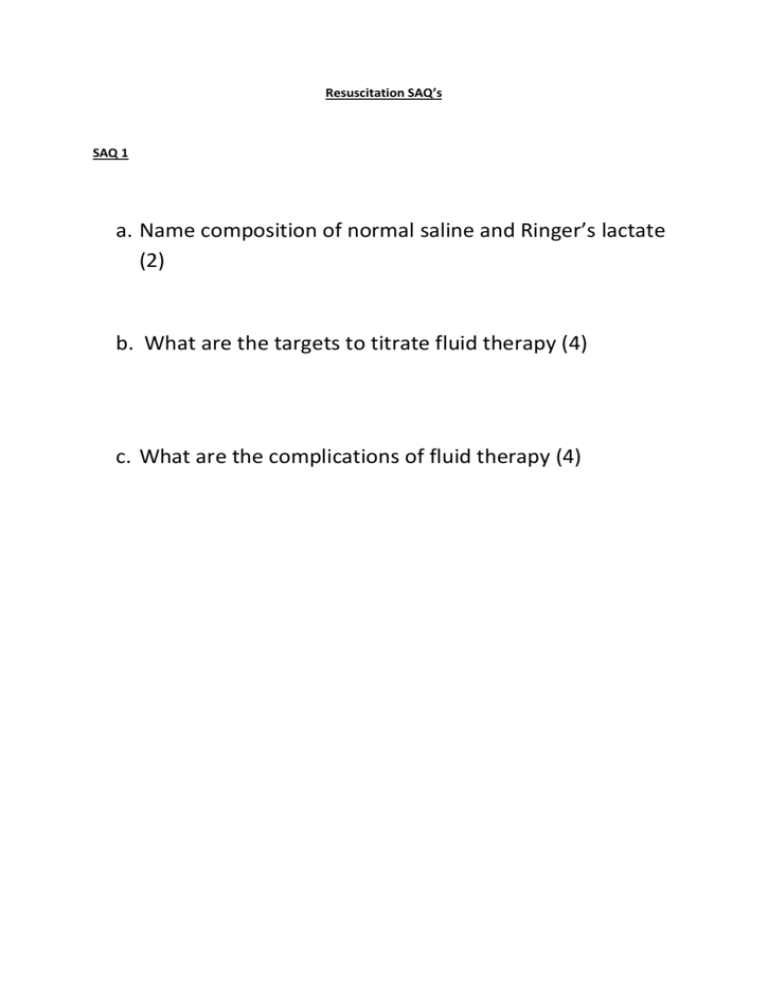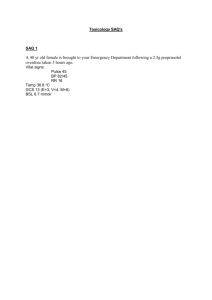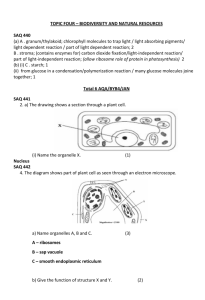Resuscitation SAQ`s
advertisement

Resuscitation SAQ’s SAQ 1 a. Name composition of normal saline and Ringer’s lactate (2) b. What are the targets to titrate fluid therapy (4) c. What are the complications of fluid therapy (4) Answers 1. Normal Saline – Sodium 154 mmol,CL 154, K+ 0, Ca++ 0 Hartmann’s – Sodium 131mmol, Chloride 111mmol, K+ 5mmol, Ca++ 2 mmol, Lactate 29mmol 2. Any 4 from the following Physiological – SBP 90, MAP > 65mmHg, HR <100 Perfusion – UOP > 0.5ml/kg/hour, Lactate <2mmol, resolving base deficit, Cap refill < 4s Invasive measurement – CI >2.5 L/min/m2, PAOP > 15 mmHg. 3. Any 4 from the following Hypothermia after large volumes of fluid therapy Coagulopathy due to dilution Tissue oedema – limb and abdominal compartment syndrome Pulmonary oedema Hyperchloraemic acidosis with NS Anaphylaxis to synthetic colloids /blood transfusion SAQ 2 1) List 4 indications for endotracheal intubation (4 marks) 2) List 2 indications for non-invasive ventilation (1 marks) 3) List 4 contra-indications to NIV (2 marks) 4) What is the mechanism of action of NIV? (3 marks) Answers 1) List 4 indications for endotracheal intubation (4 marks) To create and airway To maintain an airway To protect an airway To provide for mechanical ventilation From Cameron, Textbook Adult Emergency Medicine 2009, p 20 2) List 2 indications for non-invasive ventilation (1 mark – 0.5 each) Acute pulmonary oedema Respiratory failure (will accept COPD as alternative) Cameron, p21 3) List 4 contra-indications to NIV (2 marks – 0.5 each) Coma Combative patient Inability to tolerate tight-fitting mask Lack of trained staff to institute and monitor NIV 4) What is the mechanism of action of NIV? (3 marks) Controlled FiO2 at set positive pressure – Recruits alveoli that were closed improving VQ match Increases pulmonary compliance, decreasing work of breathing SAQ 3 A 72 year old diabetic female is brought to your Emergency Department by ambulance. She complains of feel generally unwell for the last 2 days with abdominal pain, cough and fevers. Vitals signs: Pulse BP RR Sats Temp 121 89/58 28 89% Room Air 39.8 oC a. List the key steps in this patients management ? (3 Marks) b. List your resuscitation goals for the first 6 hours ? (4 Marks) c. The patient requires inotropic haemodynamic support. Which inotrope should be used ? (1 Mark) d. The patient is intubated for respiratory failure. List the four key components of your ventilation strategy for this patient ? (2 Marks) Answers a) Resuscitation - 1/2 Mark Screening / diagnosis e.g. blood cultures / biochemistry etc. - 1/2 Mark Antibiotics - broad spectrum cover required - 1 Mark 1/2 Mark each for any two of: Source Control Monitoring Disposition Boundary of Care b) 1 Mark each up to 4 marks from: CVP 8-12 mmHg MAP >65 mmHg Urine output >0.5ml/kg/hr Central venous sats >70% or mixed venous sats >65% Lactate clearance c) Noradrenaline - 1 Mark d) 1/2 Mark for each of : Tidal volume 6ml/kg Plateau pressure <30 cm H2O PEEP Titrated to FiO2 Minimum 5 cm H2O - Maximum 24 cm H20 FiO2 Titrated to Sats 88-95% or PaO2 55-80 mmHg Answers taken from Surviving Sepsis Campaign International Guideline for Management of Severe Sepsis and Septic Shock 2012 and ARDSnet NIH NHLBI ARDS Clinical Network Mechanical Ventilation Protocol Summary SAQ 4 A55 year old woman presents by ambulance. This is her appearance upon arrival in ED a) List three differential diagnoses b) List 5 features of her medical history that are particularly important to enquire about c) State your first 5 management steps Answer a) Angioedema, Anaphylaxis, Trauma (haematoma) b) Allergy history, medication history, family history of similar events, previous episodes and how managed c) Resus with full monitoring, Adrenaline neb(5mg) and/or IM (.3-.5mg), urgent airway call (anaesthetics/ICU), difficult airway and surgical airway kit at bedside, optimise current airway by positioning, IV access, supplemental O2 if hypoxia










